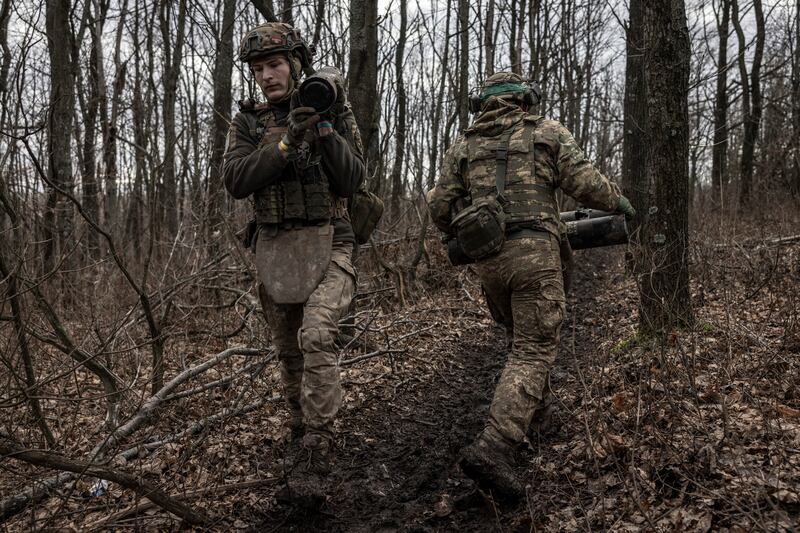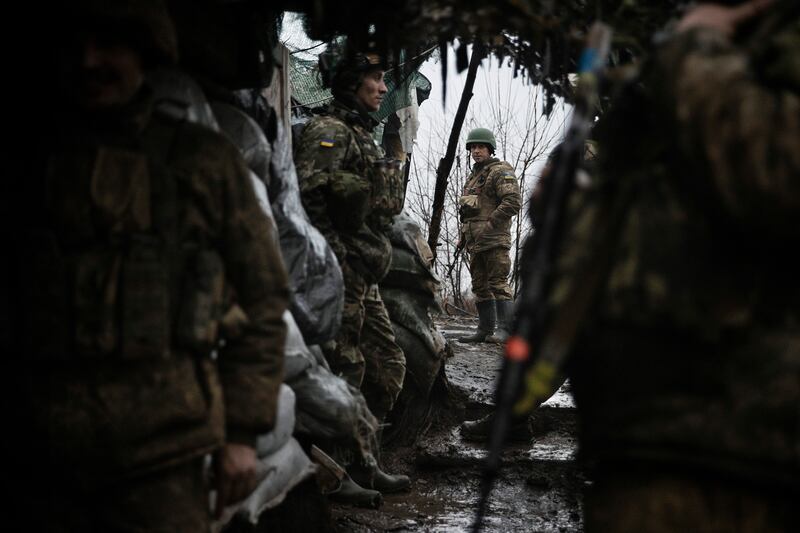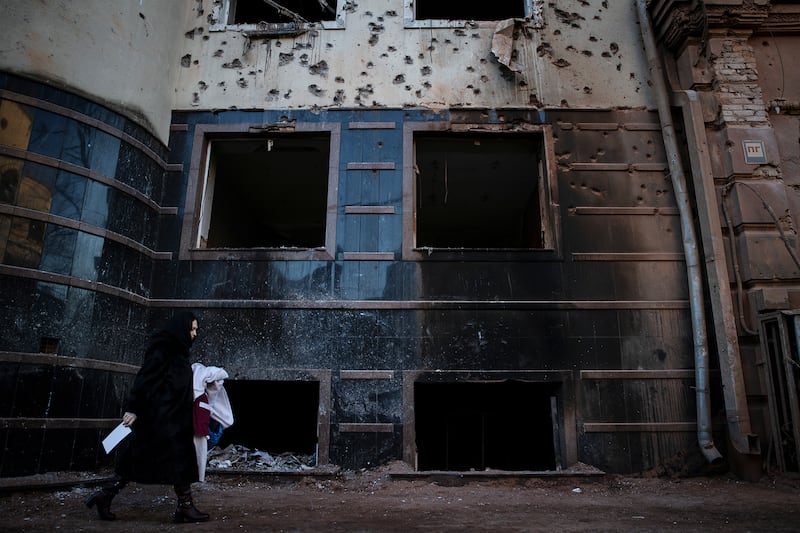A year ago, when Washington and much of Europe were still awash in optimism that Ukraine was on the verge of repelling Russia from its territory, it seemed inconceivable that the United States would turn its back on the victim of Vladimir Putin’s aggression.
Now, even as Senate Democrats try to salvage an aid package for Ukraine, that possibility remains real. And the political moment feels a long way from 14 months ago when President Volodymyr Zelenskiy of Ukraine stood before a joint session of Congress, wearing his signature drab green sweater, and basked in a minute-long standing ovation.
The turnaround has surprised the White House. Even if the Senate manages to advance military aid, there are still plenty of reasons to doubt that the money will come through, including deep opposition among Republicans in the House of Representatives and former president Donald Trump’s push for a more isolationist stance.
President Joe Biden’s aides insist they are not yet scrambling for other options.
READ MORE
“We’re not focused on Plan B,” Jake Sullivan, the president’s national security adviser, said in Brussels on Wednesday after a Nato meeting with his counterparts. “We’re focused on plan A,” which he said meant passing a bipartisan aid package that would enable Ukraine to “defend effectively and to take back territory that Russia currently occupies”.
[ Video: Footage of Ukraine kamikaze drone chasing Russian tankOpens in new window ]
But behind the scenes there is a lot of discussion, in Washington and Europe, about other options, including seizing more than $300 billion (€280 billion) in Russian central bank assets that are stashed in Western nations – a process that is turning out to be a lot more complicated than it first seemed.
Still, US officials concede there is nothing on the horizon that could match the power of a new, $60 billion congressional appropriation, which would buy bolstered air defences, more tanks and missiles, and a huge influx of ammunition.
And, they add, the symbolism of the United States pulling back now could be profound.
European officials who have been dreading the possibility that Trump might be re-elected and make good on his promise to withdraw from Nato are beginning to wonder, at least in private, about the reliability of the US, no matter who is president.
If Republicans are willing to abide by Trump’s demand that they vote against continued aid to Ukraine, one senior European diplomat in Berlin asked on Wednesday, why would they rely on Biden’s assurance that the US would “defend every inch” of Nato territory? Even some of Trump’s former national security aides – the ones he long ago split with – are beginning to say that a failure to fund Ukraine would amount to a huge strategic win for Putin.
“The United States has a clear choice: arm the Ukrainians with the weapons they need to defend themselves or cut off aid and abandon democratic Ukraine in its struggle for national survival against Putin’s aggression,” HR McMaster, who served for a year as the second of Trump’s four national security advisers, said on Monday. He noted that while Congress debated, “the abandonment of Kyiv would be a gift to the Moscow-Tehran-Beijing-Pyongyang axis of aggressors. Allies and partners would lose trust in the United States as those aggressors are emboldened”.

Oddly enough, Congress’s threat to derail the aid comes just at the moment that Europe committed €50 billion for rebuilding the country over the next four years, and countries from Norway to Germany are committing new arms aid. “It is remarkable how quickly Europe has moved toward a new and substantive multi-year support programme for Ukraine,” said Christoph Trebesch, who directs the production of the Ukraine Support Tracker at the Kiel Institute for the World Economy in northern Germany. “For the first time, the US is now lagging behind by a large margin” compared with European aid, he said.
“This is not charity; it is in our own security interest,” Nato secretary general Jens Stoltenberg said at the alliance’s headquarters Wednesday, appearing at a news conference with Sullivan. A Russian victory, he added, “matters for European security and it matters for American security”.
But this argument, that the West must push back on Russia in Ukraine or face the possibility of fighting it on Nato territory, seems to be losing its effectiveness in Congress. And some Republican members of Congress are still accusing Europe of not pulling its weight, even if the newest financial commitments change the equation.
But none of these arguments, officials in the US and Europe say, can overcome the reality: If the United States pulls the plug on its financial support for the war, much of the day-to-day military necessities will not be provided – starting with air defence against the near-daily barrages of missiles, drones and other weaponry aimed at urban centres and critical infrastructure including the electric grid. And if the country’s economy collapses, it will terminate a two-year-long effort to save a fledgling if deeply flawed democracy.
The Republicans opposing the aid don’t argue directly with that logic, although many insist that pouring billions into a country with a deep history of corruption invites misuse. Instead, their primary argument is that the money should be spent at home, on the southern border rather than Ukraine’s borderlands with Russia. The most outspoken of the opponents, including House members Marjorie Taylor Greene of Georgia and Matt Gaetz of Florida, contend that Ukraine aid “puts the United States last”.

For months, the White House saw them as a fringe group. But polling shows that the percentage of Republican voters who say the US has spent too much defending Ukraine is soaring. And now many Republicans have grown resistant, aligning their own views with the long-held position espoused by Trump, who in the 2016 campaign said he did not want to defend Ukraine. Eight years later he is insisting – without offering any details – that he would end the war in 24 hours.
Now the opposition has so taken hold that even the Senate Republican leader, Mitch McConnell of Kentucky, who has declared time and again that funding the war in Ukraine was one of his top priorities, seems to be back-pedalling.
Meanwhile, Biden’s aides are trying to figure out how to pay for weapons if Congress remains paralysed. The plan to seize Russian assets has complications. It’s not clear that the reserves could be used to pay for air defence and artillery. Even that, administration officials say, could require congressional action – although presumably there are more votes in the House and Senate for spending Russia’s money than spending the US’s.
There is also discussion of conducting complex weapons swaps, similar to what Japan and South Korea have done, where they have provided their artillery shells to the US, freeing up Washington to give more to Ukraine. (Both countries have said they could not export directly to a war zone.) Or, perhaps, have European nations pay for American weapons and ship those to Ukraine.
But Europe clearly doesn’t have the capacity to provide much more ammunition by itself. During the 30 years of increasingly uneasy peace with Russia, Europe dismantled much of its production capability. European Commission president Ursula von der Leyen said in a recent speech that “we will have delivered over half a million rounds of artillery shells by next month” and “more than one million by the end of the year”, but she acknowledged that “this is certainly not enough”.
Europe also has little to contribute to drone manufacturing. And Germany remains unwilling to turn over its most powerful long-range, air-launched cruise missile, the Taurus, for fear it will be used deep inside Russian territory. Germany’s role is bound to be at the centre of a meeting between chancellor Olaf Scholz and Biden at the White House on Friday.
Sullivan, for his part, insists that if the administration sticks to its strategy, it will prevail. “Walking away from Ukraine at this moment, at this time, would be fundamentally wrong for the basic national security of the United State and for our Nato allies, as well,’’ he said on Wednesday. “And we think we will continue to win that argument.” – This article originally appeared in The New York Times



2024 The New York Times Company












